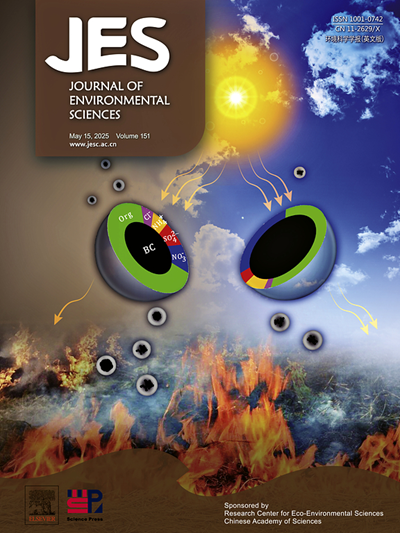Cumulative effect of PM2.5 chemical components surpasses PM2.5 mass on hypertension in older adults: A China-based national analysis
IF 5.9
2区 环境科学与生态学
Q1 ENVIRONMENTAL SCIENCES
引用次数: 0
Abstract
The specific and cumulative effects of fine particulate matter (PM2.5) components on hypertension remain less defined, notably in susceptible older adults. This national study utilized a representative sample of 220,425 older adults in China, to scrutinize their relationship. Residential PM2.5 and five chemical components (black carbon (BC), organic matter (OM), sulphate (SO42−), nitrate (NO3−), and ammonium (NH4+)) were estimated by the bilinear interpolation. Associations between PM2.5 and five chemical components with hypertension were examined through two-stage logistic regression models, with population attributable fractions (PAFs) determined via counterfactual analysis. Elevated exposure to PM2.5 and its components was generally linked to higher hypertension prevalence. With each interquartile range increase, the odds ratio (OR) of hypertension rose by 1.09 (95 % CI: 1.08–1.11) for NO3−, 1.06 (95 % CI: 1.05–1.08) for NH4+, 1.06 (95 % CI: 1.05–1.07) for OM, 1.05 (95 % CI: 1.04–1.06) for BC, and 1.06 (95 % CI: 1.04–1.07) for SO42-. Notably, the cumulative impact of five PM2.5 chemical components (OR: 1.13, 95 % CI: 1.12–1.13) was significantly greater than the effect of total PM2.5 mass alone (OR: 1.04, 95 % CI: 1.03–1.05). Regarding PAFs, NO3− represented the strongest contribution to hypertension, followed by OM, NH4+, SO42−, and BC. Furthermore, the effects were accentuated in low socio-economic population. These findings underline that using total PM2.5 as a surrogate marker may underestimate the comprehensive impact of its chemical components, underscoring the necessity for targeted interventions to reduce emissions of specific PM2.5 chemical constituents.
PM2.5化学成分累积效应超过PM2.5质量对老年人高血压的影响:一项基于中国的国家分析
细颗粒物(PM2.5)成分对高血压的具体和累积影响尚不明确,特别是在易感老年人中。这项全国性的研究利用了中国220,425名老年人的代表性样本,来仔细研究他们之间的关系。采用双线性插值法估算了PM2.5和5种化学成分(黑碳(BC)、有机质(OM)、硫酸盐(SO42−)、硝酸盐(NO3−)和铵(NH4+)。通过两阶段逻辑回归模型检验PM2.5和五种化学成分与高血压之间的关系,并通过反事实分析确定人口归因分数(paf)。PM2.5及其成分暴露水平升高通常与高血压患病率升高有关。随着每一个四分位数区间的增大,NO3−的优势比(OR)增加1.09 (95% CI: 1.08-1.11), NH4+的优势比增加1.06 (95% CI: 1.05 - 1.08), OM的优势比增加1.06 (95% CI: 1.05 - 1.06), BC的优势比增加1.05 (95% CI: 1.04-1.07), SO42-的优势比增加1.06 (95% CI: 1.04-1.07)。值得注意的是,五种PM2.5化学成分的累积影响(OR: 1.13, 95% CI: 1.12-1.13)显著大于PM2.5总质量单独的影响(OR: 1.04, 95% CI: 1.03-1.05)。在paf中,NO3−对高血压的贡献最大,其次是OM、NH4+、SO42−和BC。此外,这种影响在社会经济地位较低的人口中更为突出。这些发现强调,使用PM2.5总量作为替代指标可能会低估其化学成分的综合影响,强调有针对性的干预措施以减少特定PM2.5化学成分的排放的必要性。
本文章由计算机程序翻译,如有差异,请以英文原文为准。
求助全文
约1分钟内获得全文
求助全文
来源期刊

Journal of Environmental Sciences-china
环境科学-环境科学
CiteScore
13.70
自引率
0.00%
发文量
6354
审稿时长
2.6 months
期刊介绍:
The Journal of Environmental Sciences is an international journal started in 1989. The journal is devoted to publish original, peer-reviewed research papers on main aspects of environmental sciences, such as environmental chemistry, environmental biology, ecology, geosciences and environmental physics. Appropriate subjects include basic and applied research on atmospheric, terrestrial and aquatic environments, pollution control and abatement technology, conservation of natural resources, environmental health and toxicology. Announcements of international environmental science meetings and other recent information are also included.
 求助内容:
求助内容: 应助结果提醒方式:
应助结果提醒方式:


